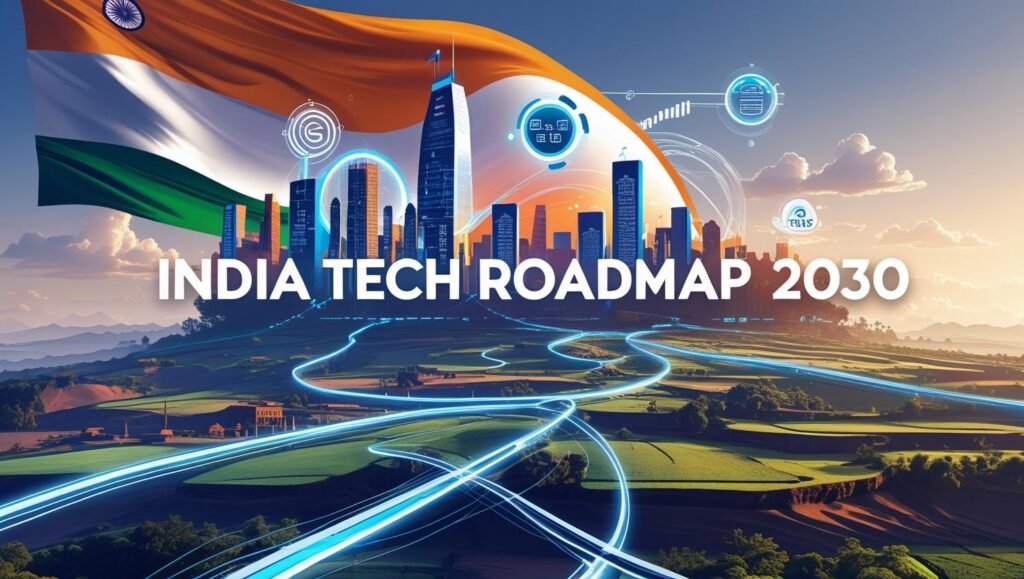Introduction: Powering India’s Digital Future
India is rapidly transforming into a digital-first economy, with its eyes set firmly on 2030. Through ambitious initiatives, government-backed programs, and technological policy frameworks, the country is building the foundation of a robust and inclusive digital ecosystem. At the core of this transformation lies India Tech, a growing network of programs and innovations designed to connect, empower, and digitally enable more than a billion citizens.
The Government technology roadmap India 2030 is more than a vision—it’s a plan to future-proof India’s socio-economic landscape by strengthening infrastructure, expanding internet access, boosting innovation, and driving public-private collaboration.India’s ambitious national technology roadmap—widely known as the India Tech strategy—aims to transform the nation into a global digital powerhouse.
Major projects like Digital India and BharatNet are central to this shift, promising to connect every village with high-speed internet and bring every citizen into the digital fold. This article explores the core pillars of the roadmap, key initiatives, challenges, and how to apply for grants or get involved via official government platforms such as the MeitY official portal.
India’s Tech Strategy Overview: Vision 2030
The Government of India has outlined a multi-tiered technology strategy aimed at transforming India into a leading global digital economy by 2030. Key goals include:
- Enhancing nationwide digital connectivity
- Promoting AI, IoT, quantum computing, and other emerging technologies
- Creating smart governance through automation and digitization
- Supporting local manufacturing under the “Digital Sovereignty” mission
- Accelerating startup ecosystems in sectors like agritech, healthtech, and fintech
This roadmap aligns with broader goals like inclusive growth, transparency, and innovation. It seeks to answer: “What’s India’s tech strategy?” and how can it benefit every citizen—from urban tech entrepreneurs to rural farmers.

Key Initiatives Driving the India TechRoadmap
India’s technology journey to 2030 is being driven by a portfolio of high-impact initiatives:
🚀 1. Digital India: Laying the Foundation of a Tech-Enabled Nation
Launched in 2015, Digital India aims to transform India into a knowledge economy. By 2025, it’s expanding its scope with:
- DigiLocker: Secure cloud-based document access for citizens
- e-Sign: Instant digital document authentication
- Unified Mobile App for New-age Governance (UMANG): Access to 1200+ services on a single platform
- AI-based public service delivery: For schemes like PM-Kisan and Ayushman Bharat
Digital literacy training programs are also bridging the knowledge gap in rural and semi-urban areas.
🌐 2. BharatNet: Connecting Rural India with High-Speed Internet
A flagship of the India Tech vision, BharatNet is the world’s largest rural broadband project. Its aim: provide 100 Mbps internet to over 600,000 villages across India.
Key Features:
- Optical fiber infrastructure spanning over 2.5 million kilometers
- Public Wi-Fi hotspots in Gram Panchayats
- Enhanced digital delivery of education, healthcare, and government services
BharatNet plays a critical role in connecting citizens to national digital resources and unlocking opportunities for businesses and service providers.This initiative plays a major role in India Tech transformation goals by 2030.
🏙 3. Smart Cities Mission
India plans to make 100+ cities “smart” by integrating:
- IoT-based traffic management
- Predictive public utilities
- Smart grids for energy efficiency
- E-governance dashboards for real-time municipal services
These cities are testbeds for larger innovation ecosystems across the country.
🛰 4. IoT and Emerging Tech
India is accelerating the deployment of:
- Internet of Things (IoT) in agriculture and healthcare
- 5G networks with local R&D
- AI-powered analytics in public safety, disaster response, and governance
- Quantum tech & semiconductors via investments in research hubs
This tech-first policy will define how India remains globally competitive in the next decade.
📲 5. E-Governance and Cybersecurity
Digital public goods and e-governance portals have become standard. With this growth comes the challenge of security.
The roadmap includes:
- National Cybersecurity Coordination Centre
- Citizen Data Protection Bill
- AI-driven threat detection systems
For more insight into tech-driven defense, see this internal article:
👉 Cybersecurity Tech Roadmap 2025
💰 Funding and Grants: How to Get Involved
As part of its Digital India and India Tech push, the government has launched numerous schemes allowing innovators, startups, and educational institutions to apply for grants in emerging technologies.
🔍 How to Apply:
- Visit the MeitY official portal to view current funding schemes
- Programs like “Digital India Innovation Fund” and “Technology Incubation & Development of Entrepreneurs” (TIDE) are popular
- Submit proposals aligned with key sectors: healthtech, fintech, cybersecurity, agritech
Early-stage startups may also benefit from support through accelerators and incubators backed by NITI Aayog and the Department of Science & Technology.
🧭 Navigating the MeitY Portal and BharatNet
The Ministry of Electronics and Information Technology (MeitY) acts as the core facilitator of India’s digital transformation.
MeitY Portal Resources:
- Live dashboards for Digital India KPIs
- Grant and funding application forms
- Research calls and internship opportunities
- Public feedback channels on draft policies
BharatNet's Growing Impact:
- Launched Phase-II with PPP (Public-Private Partnership) model
- Enabling fintech expansion, rural telemedicine, and distance education
- Works alongside CSCs (Common Service Centers) to localize services
Together, BharatNet and MeitY ensure that no region is left behind in India’s national tech vision.
⚠️ Challenges and Future Outlook
While India’s tech roadmap is visionary, it isn’t without hurdles:
Key Challenges:
- Infrastructure bottlenecks in remote areas
- Uneven digital literacy
- Cybersecurity threats and data privacy concerns
- Coordination among federal and state bodies
What’s Ahead for 2030 and Beyond:
- Integration of AI governance frameworks
- Expansion of quantum computing labs in public universities
- Large-scale implementation of climate tech and smart agriculture
- Cross-border data policy standardization and compliance
By 2030, India’s digital economy is expected to exceed $1 trillion, positioning the country as a global innovation hub.
✅ Conclusion: Why India’s Tech Roadmap Matters Now More Than Ever
India’s Government technology roadmap India 2030 represents more than digital development—it’s about empowering 1.4 billion people to live smarter, safer, and more connected lives.
From BharatNet and Digital India to smart cities and AI innovation, every initiative is a step toward inclusive digital empowerment.
Stakeholders—including startups, researchers, entrepreneurs, and NGOs—should proactively visit the MeitY official portal, explore how to apply for grants, and align themselves with India’s growing tech strategy.
India’s technology transformation isn’t a dream of the future—it’s the blueprint for a better, more connected nation today.







